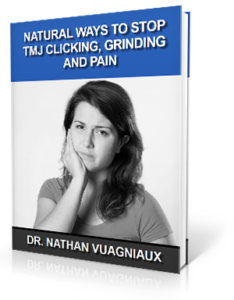 It isn’t uncommon to hear of people complaining about their TMJ, or temporomandibular joint. Your jaw is a big hinge, and the TMJ connects the bottom portion of the jaw with the temporal bones of the skull on each side. We rely on our jaw for chewing, talking, and yawning. For a jaw that isn’t working properly, any of these motions can cause a great deal of pain or discomfort.
It isn’t uncommon to hear of people complaining about their TMJ, or temporomandibular joint. Your jaw is a big hinge, and the TMJ connects the bottom portion of the jaw with the temporal bones of the skull on each side. We rely on our jaw for chewing, talking, and yawning. For a jaw that isn’t working properly, any of these motions can cause a great deal of pain or discomfort.
Problems with the jaw can have several causes, including trauma, clenching or grinding of the teeth, and stress. People with disorders of the TMJ not only experience painful jaw movement but can also have neck pain, changes in hearing, and headaches.
To learn more about the connection between head and neck injuries and TMJ download our complimentary e-book by clicking the image below.
Your Jaw and Your Neck
It is very common for jaw pain to radiate around the ear, down to the neck, or even cause headaches. A connection between the upper cervical spine and the TMJ is clear. When the atlas vertebra, the uppermost bone in the neck, is out of alignment, it can cause asymmetry in muscle tension and posture. This can create an imbalance in how the jaw moves, which can lead to pain and dysfunction. The atlas also protects a critical area of the central nervous system—the brainstem. The nerves that branch from the brainstem give function and feeling to the face and head, making the position of the atlas even more important.
At Upper Cervical Care Edwardsville, we take a very detailed look at the alignment of the upper cervical spine to see if it’s contributing to your TMJ issues. If we do find that your atlas is not normally aligned, then gentle, precise upper cervical adjustments can correct the problem. The goal is to make corrections that last so that your body has the necessary time it needs to heal properly.
To schedule a complimentary consultation call 618-307-9494 or just click the button below.


